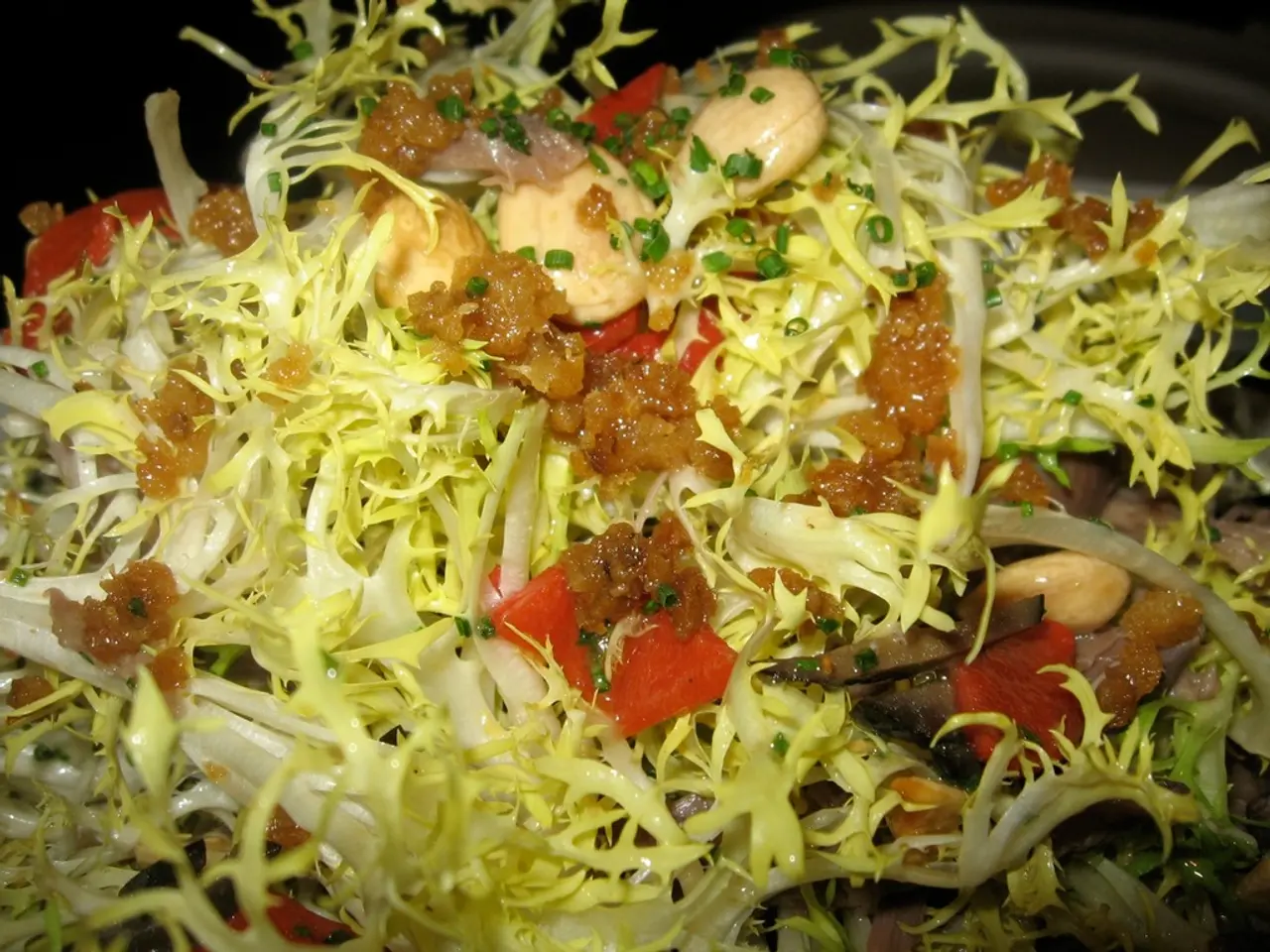Preparing Foods for Optimal Nutrient Content: A Comparison Between Raw and Cooked Natural Foods
In the ongoing debate about the benefits of raw versus cooked food, it's clear that both diets have their merits. Each approach offers unique advantages and challenges, and understanding these can help individuals make informed decisions about their dietary choices.
A raw food diet, which includes fruits, vegetables, nuts, seeds, and some grains in their most natural, unprocessed form, offers nutritional benefits such as higher retention of heat-sensitive vitamins (like vitamin C and certain B vitamins), natural enzymes that aid digestion, and preservation of antioxidants and phytochemicals that combat oxidative stress. Raw fruits and vegetables, such as tomatoes, also provide benefits like improved heart health, immune support, and skin hydration due to nutrients like potassium, lycopene, and vitamin C.
However, there are challenges with a raw food diet. Raw foods can harbor pathogens such as bacteria and parasites, increasing the risk of foodborne illnesses, especially with raw meats. Raw cruciferous vegetables and some plant foods contain antinutrients (e.g., lectins, phytic acid, oxalates) that can impair nutrient absorption and are better consumed cooked or soaked. Additionally, raw diets may lead to vitamin B12 deficiency since this vitamin is mostly found in animal products that are generally consumed cooked. Some foods are harder to digest raw, and raw diets might cause digestive inflammation in sensitive individuals.
In comparison, cooked food diets reduce pathogen risk by killing harmful microbes and can improve digestibility by breaking down complex fibers and neutralizing antinutrients. Cooking often enhances bioavailability of certain nutrients like lycopene in tomatoes and beta-carotene in carrots. However, cooking also leads to some nutrient loss, particularly of heat-sensitive vitamins and enzymes. Properly cooked diets balance safety and nutrient availability but may lose some antioxidants or water-soluble vitamins.
To summarize:
| Aspect | Raw Food Diet | Cooked Food Diet | |-----------------------------|----------------------------------------------------------|----------------------------------------------------------| | Vitamin retention | Higher retention of heat-sensitive vitamins (C, B) | Some loss of vitamins due to heat | | Enzymes | Natural enzymes retained, aiding digestion | Enzymes destroyed by cooking | | Antioxidants | Preserved fully | May be partially reduced but some (like lycopene) enhanced | | Pathogen risk | Higher risk of bacteria, parasites | Reduced risk by heat killing pathogens | | Digestibility | Some foods difficult to digest raw | Cooking softens foods, improves digestibility | | Antinutrients | Present in raw foods, can inhibit nutrient absorption | Reduced or neutralized by cooking | | Nutritional deficiencies| Risk of vitamin B12 deficiency | Lower risk if animal foods consumed cooked | | Health considerations | May cause digestive inflammation for some; more natural | Safer for immunocompromised individuals due to pathogen reduction |
Many nutrition experts recommend a balanced approach including both raw and cooked foods for optimal nutrition and safety. The benefits of eating raw foods include preservation of enzymes, higher vitamin and mineral content, increased fiber, better hydration, and potential weight management. Cooking food can kill harmful bacteria, parasites, and viruses, ensuring food safety and preventing foodborne illnesses. Cooking changes the texture of foods, making them more appealing to many people.
Ultimately, the choice between a raw and cooked food diet depends on individual preferences, dietary needs, and lifestyle. A balanced diet that includes both raw and cooked foods can provide a variety of nutrients that are easier to digest, absorb, and enjoy, while also mitigating the challenges associated with each approach.
[1] Nutrition Australia. (2021). Raw vs Cooked Foods: What's the Difference? https://www.nutritionaustralia.org/national/resource/raw-vs-cooked-foods-whats-difference [2] Mayo Clinic. (2020). Raw Food Diet: What You Need to Know. https://www.mayoclinic.org/healthy-lifestyle/nutrition-and-healthy-eating/in-depth/raw-food-diet/art-20046049 [3] Harvard T.H. Chan School of Public Health. (2021). Tomatoes. https://www.hsph.harvard.edu/nutritionsource/food-features/tomatoes/ [4] Harvard T.H. Chan School of Public Health. (2021). Carrots. https://www.hsph.harvard.edu/nutritionsource/food-features/carrots/ [5] Healthline. (2020). Raw Food Diet: Benefits, Risks, and What to Eat. https://www.healthline.com/nutrition/raw-food-diet-benefits-risks-and-what-to-eat
- In the realm of health-and-wellness, a balanced approach to nutrition often involves both raw and cooked foods, as endorsed by various experts.
- Raw food, such as fruits, vegetables, nuts, and seeds, offers unique advantages like high retention of heat-sensitive vitamins and natural enzymes that aid digestion.
- Food-and-drink choices that fall under a raw diet also include benefits like improved heart health, immune support, and skin hydration due to nutrients like potassium, lycopene, and vitamin C.
- However, a raw food diet may pose challenges, such as an increased risk of foodborne illnesses, antinutrient impairment of nutrient absorption, potential vitamin B12 deficiencies, and digestive inflammation for some individuals.
- Cooked diets, in contrast, can reduce pathogen risks and improve digestibility by breaking down complex fibers, neutralizing antinutrients, and enhancing bioavailability of certain nutrients like lycopene in tomatoes and beta-carotene in carrots.
- Personal preferences, dietary needs, and lifestyle play significant roles in determining whether a raw or cooked food diet is more suitable for an individual, as a balanced diet that includes both can mitigate the challenges associated with each approach, providing easier digestion, absorption, and enjoyment of a variety of nutrients.




